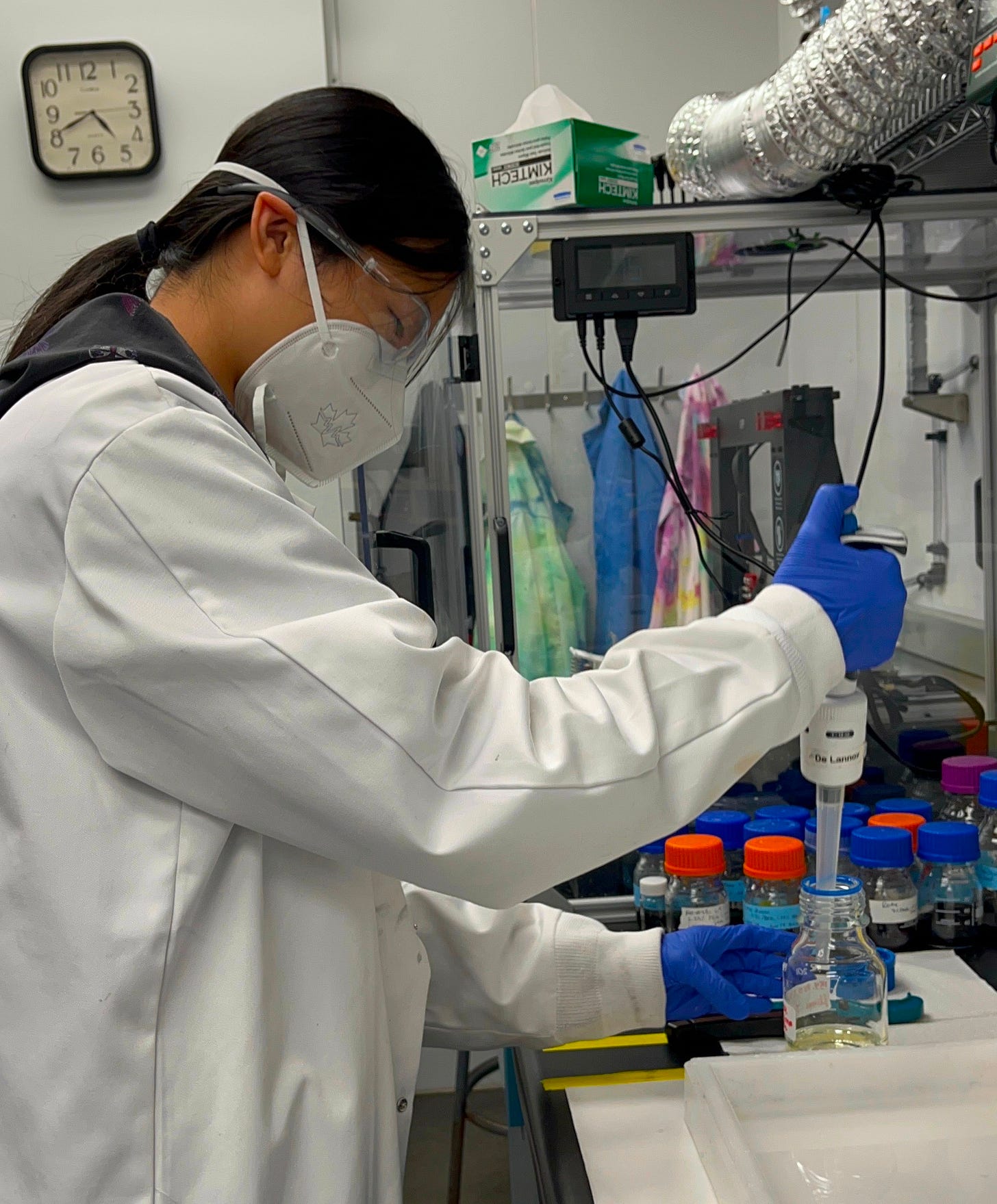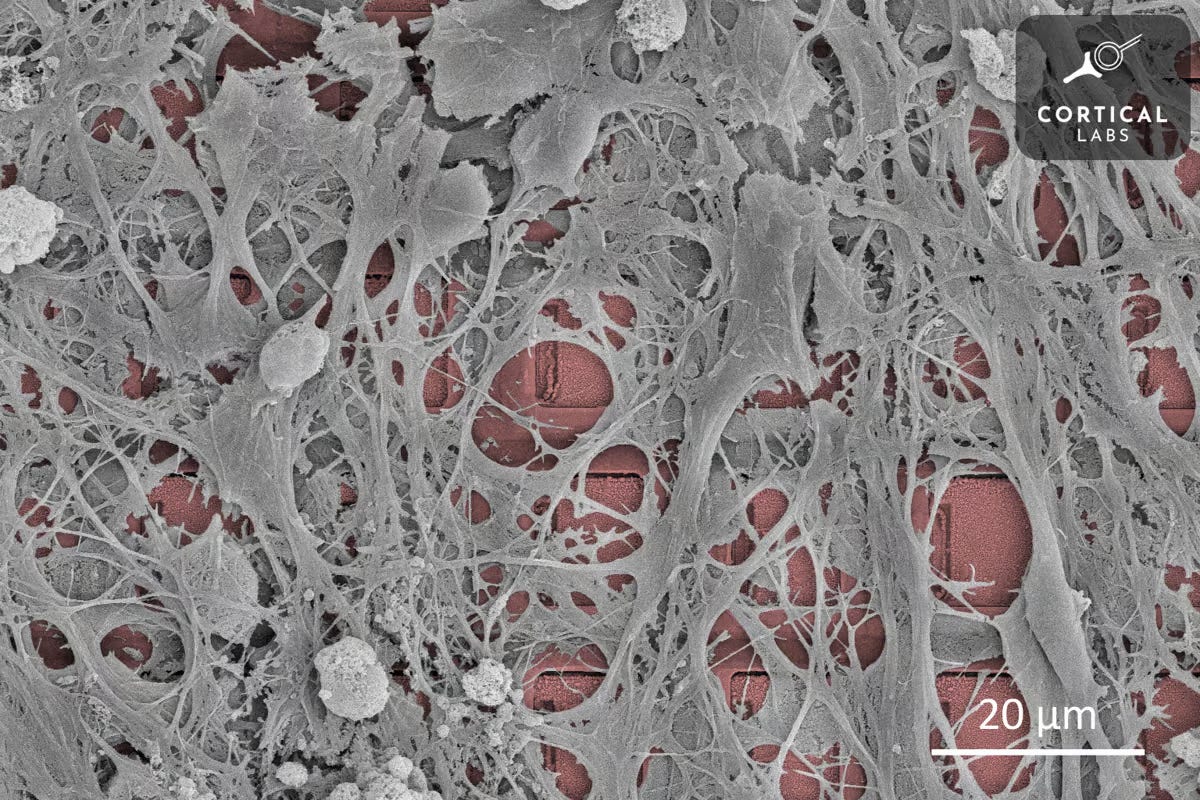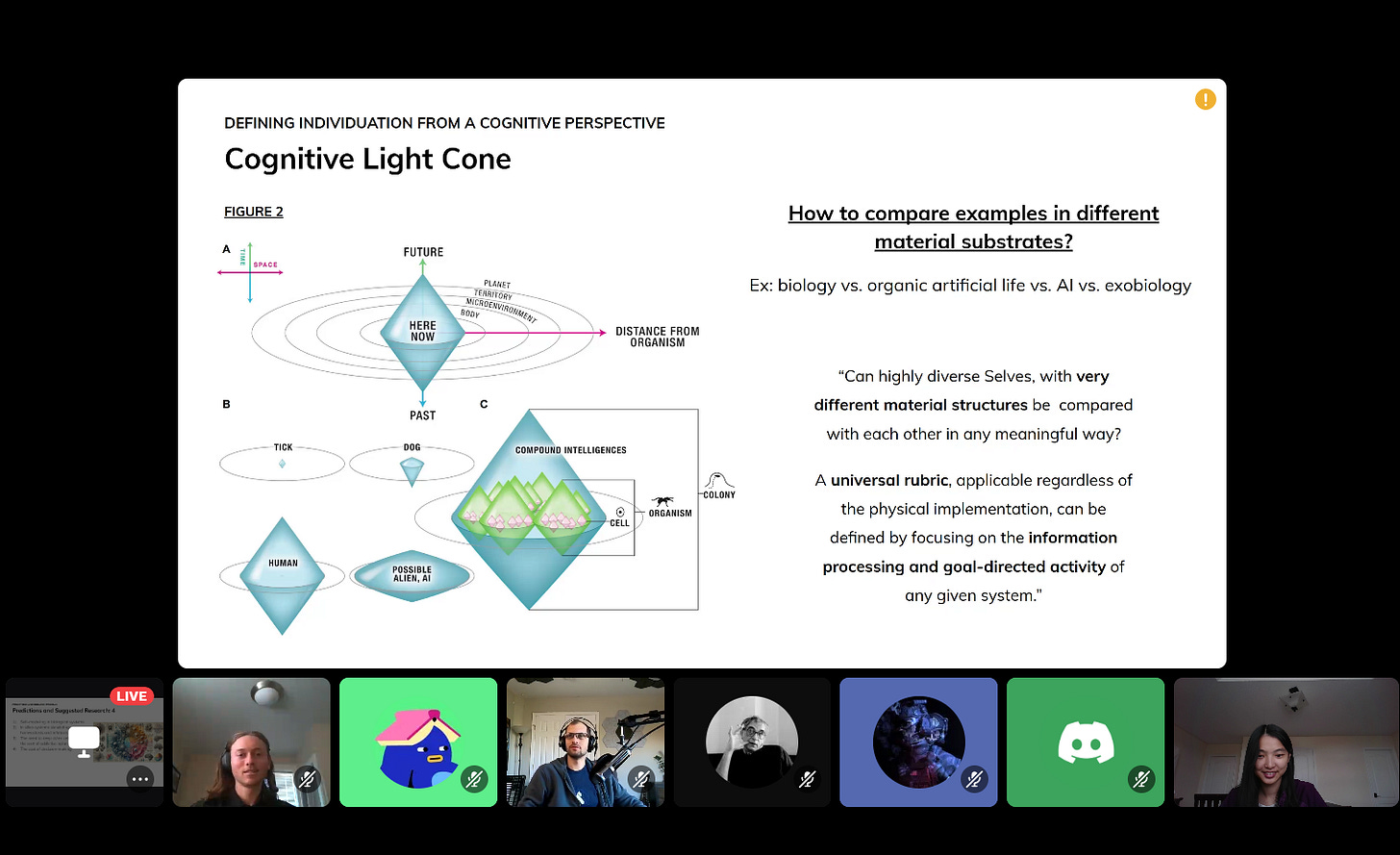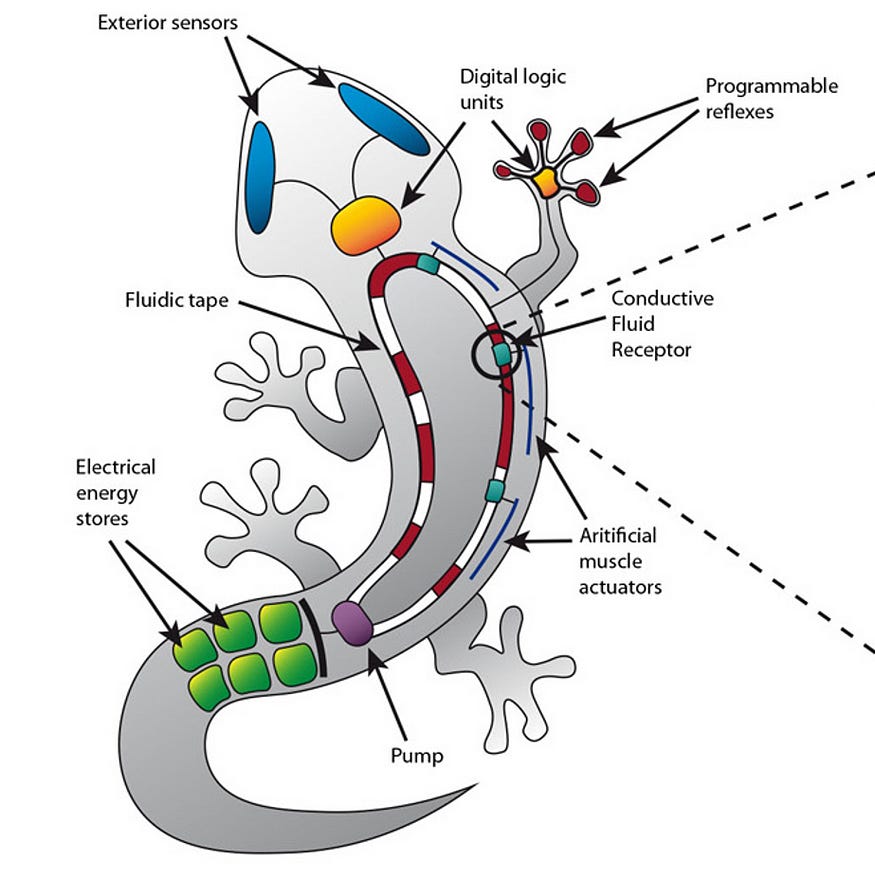Anthrobots, Exploring Biohybrid Robotics, Hosting Cortical Labs Journal Club
Melyne Zhou | September & October Newsletter 🍂🎃🧠
Hey there! I’m Melyne, and welcome to my Mind & Matter newsletter. I’m a 16 y/o obsessed with biohybrid robotics and unconventional computation. Keep reading to see what I’ve been up to in September and October!
Spotlight Series: Anthrobots 🫁🧫
This spotlight series is not about a material (more on that later), but is just as exciting! In 2021, researchers from Tufts University and Harvard University's Wyss Institute made xenobots from embryogenic cells from the African clawed frog (Xenopus laevis). Xenobots are super cool, with the ability to reproduce and aggregate cells in groups—so naturally, people began to wonder whether or not they could be made with mammalian cells.
That’s where anthrobots come in! Anthrobots are made from human lung epithelial cells, and are around 30-500 µm in diameter. Unlike xenobots, anthrobots are not embryonic, instead made from adult cells which have had many years to grow in the trachea. They move around with cilia, and interestingly, formed clusters of “superbots” when confined in space.

But that’s not the coolest thing the researchers found. When they were placed on a sheet of human peripheral nerve cells scratched with a scalpel, the anthrobots created a small bridge of cells over the wound, effectively healing the cut! Amazing, I know. You can read more in this paper, or this press release.
What’s awesome is the anthrobots can be made from a patient’s own cells, decreasing the likelihood of immunosuppression, which is a big problem with nanobots in therapeutics. We’re not there yet, but one can imagine a future of personalized medicine where anthrobots assist with lower-risk surgical procedures, sense tumours, and aid in long-term drug delivery to patients!

This development is also part of a greater set of theories about the link between genome and structure and a resulting function. The genome of these anthrobots is entirely known. Yet when given a specific set of conditions, these biobots come together to heal neural wounds and build self-assembled clusters. Who knows what else they could do?
There also needs to be more work done to determine where exactly they lie on the spectrum of cognition, as with xenobots. Can we train them, and if so, how? What rules govern how these cells assemble and work together?
Some Life Updates… 💭
Before you move on, I want to acknowledge some changes I went through! You might have read the title on this post wondering whether or not this is the same newsletter you subscribed to.
This is a bit of a full-circle moment for me. My first post was made 1 year ago, on November 6th, 2023. Since then, I’ve gone through my fair share of pivots, having:
Worked in a lab @ the University of Toronto for ML x robotics x alloys
Built a chitosan-crosslinked membrane in a lab @ McMaster University (inspired by this proposal I wrote)
Started exploring soft robotics, which led me to what I’m working on now: biohybrid robotics!
For more context; near the end of June 2024, I became drawn towards bioengineering solutions to climate problems, like algae for carbon capture and materials production. I also became curious about robotics and related tangents of computation.

The list of fascinating topics (which kept me up at night, but weren’t quite related to materials science) grew longer and longer—connectomics, complexity theory, organoid intelligence, and so on. I was halfway through writing an article on soft robots when I came across a paper about living cells as actuators. That was the first time I came across the concept of using living cells in robots, and I knew right away this is sometime I had to learn more about.
I had tons of questions—what if we used cells not only as actuators, but as the “control” body in robots? Where do goals achieved by cells come from, and is it possible to program and/or re-encode them? What abilities can we give bioengineered systems using not just standard C2C12 mouse cells, but cells from other organisms?

I’ve spent the past two months falling down rabbit holes to answer these questions. I definitely haven’t fully gotten full answers, mostly because no one knows the answers yet. And that’s part of what’s so exciting to me—there’s so much much work left to be done because of how young and new the field is!
What’s so special about biohybrid robotics? This is how I think of it:
Most people are excited about humanoid robots, which imitate human beings with gears and screws. But what if we incorporate biological components, living cells and tissues, to enable robots to do things human beings can’t?
The above is a somewhat idealistic view I had when first started exploring all this, but the point still stands. To me, a robot is really any system that works in 4D (3D space, and the 4th dimension of time) to pursue a set of goal(s). And biology is one of the most fascinating places to look for unconventional goal-seeking!

Cells are fundamentally amazing problem-solving agents, as demonstrated by the anthrobots, which quickly learned to “stitch up” neural wounds. There are tons more examples of this in biology, from neurogenesis in newly born moths to planarian flatworms regenerating entire heads.
Side note: I might write a separate post just on why I’m excited about biohybrid robots—this is definitely getting too long for the contents of this newsletter.
Interestingly, exploring this space has been a weird journey of watching some of my obscure, seemingly unrelated obsessions merge into one. It’s like watching a timelapse of all the continents of my interests—from behavioural psychology, biofabrication, and insomnia-inducing epistimology—crashing into each other to form a Pangaea.
I’d like to point out I haven’t abandoned materials science in any way—more that I’ve added it to a toolbox, filled with other tools. I loved the process of breaking down how interesting materials work looking at their atoms, and I still do! I don’t think much good comes out of restricting your knowledge domain and skillset to just one area. After all, great work is often highly multidisciplinary!
I also know that practically, biohybrid robots are very far away. I also realize I’m very young, and that I’m due for my fair share of more pivots down the line. But I’ve never been so excited about anything else in my life, and I think I’ll be sticking with this rabbit hole for a while.
A Nervous System for Soft Robots🦿
Soft robots are interesting for their physical capabilities, handling delicate materials (ex: a strawberry, sadly but easily demolished by a metal gripper) and navigating environments which require more dexterity and less rigidity.
The problem is that traditional robots rely on hard microprocessors, which are too clunky and would destroy the purpose of a soft robot being, you know, soft. As a result, many soft robots rely on manually controlled movement or stimulus-response actuation, limiting movement to linear relationships.
But if the goal is fully autonomous and soft robots, we need to enable multifunctional movement and more complex behaviours. That’s where the SMC, or soft matter computer, comes in. Inspired by vascular systems in biology, the system involved fluidic tape and a conducting and insulating fluid. The goal is to enable both analog and digital computation for a wider range of movements.
While the entire proposed system has not been achieved, the researchers tested partial experimental configurations of the SMC in different soft robots, like a soft robotic gripper and an earthworm. Read more about these in my article on Medium!
Note: This is that article on the backburner I mentioned earlier. I wrote this before some of my views on “control systems” in robots and other intelligent systems changed.
Cortical Labs Journal Club 📖🧠
In September, I had the most fun attending Cortical Lab’s journal club! For those who haven’t heard of Cortical Labs—they’re working on growing brains on chips for computation. They’re one of the leading startups in the field of organoid intelligence (OI), which focuses on novel biocomputing with brain organoids.
They built the DishBrain in 2022, featuring human-derived neurons grown on microelectrode arrays (MEAs) which were trained to play Pong. They have been working on scaling CL2 following CL1, for alternative computing in data centers!

In September, our wonderful presenter shared this paper, which sparked a few questions about limits to learning in similar organoid systems. A few others in the call also loved this discussion, so we ended up hosting the October journal club on Prof. Michael Levin’s The Computational Boundary of a “Self”: Developmental Bioelectricity Drives Multicellularity and Scale-Free Cognition on just this topic!
In the image below, I’m explaining the cognitive light cone, which Prof. Levin developed with the intention of providing an invariant scale to compare the cognitive boundaries of different systems (biological or otherwise). Levin says the boundary of an Individual (and therefore, a Self) and the scale of goals it can pursue is determined by the boundaries on its information processing capacity in 3D space and time.

For instance, dogs have been shown to retain memory far back in the past. However, they have a limited ability to plan in the future. On the other hand, humans can remember and plan for events decades into the past and future—such as individuals who pursue goals which far surpass their lifetime, like planetary expansion.
Some of my favourite takeaways/discussion points from this journal club:
Where does knowledge live? — If the cognitive boundary is determined by its information processing and the scale of goals it can achieve, where are such information patterns stored?
Humans as a hive mind — If you poke one side of “humanity,” we see reactions on the other end. What are implications of viewing humans as a collective of intelligences?
Connecting theories on cognition — How do presented theories, like the cognitive light cone, compare to other theories on intelligence, such as the Free Energy Principle/Active Inference?
Here’s some other interesting papers we considered for journal club. Huge thanks to Peter from Cortical Labs for organizing journal club, and to Brennan, for being an amazing co-presenter!
What’s Next?
Flying out to Portugal to speak at Web Summit! ✈️
DIY at-home biology in my basement 🧫
Thoughts on oxygenation and goal-seeking 🤔
Thanks for reading! Feel free to reach out on LinkedIn if you’d like to have a conversation about any of the above topics. Until next time! 👋





Nice update Melyne :)